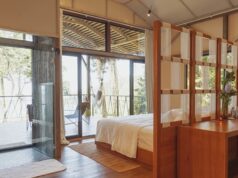 NATIONAL REPORT—From an industry penetration standpoint, mattress encasements are still in their “infancy stage,” says Sandy DiVito, vice president Hospitality & Healthcare for Protect-A-Bed. Increasingly, however, lodging establishments are using encasements to extend the life of their mattresses, keeping them out of the landfill and ready for the day when they can either be donated or recycled. From a sustainability standpoint, there is more than meets the eye when it comes to encasements. Encasements reduce the need to clean or treat mattresses, which is often done with toxic chemicals. A reduced need to clean means less labor and less guestroom down time. Encasements help provide a more healthful sleep experience for guests by keeping dust mites, allergens, dead skin cells, unhealthy bacteria, mold and other unmentionables away from the mattress. Finally, they are one step among other important steps in bed bug prevention.
NATIONAL REPORT—From an industry penetration standpoint, mattress encasements are still in their “infancy stage,” says Sandy DiVito, vice president Hospitality & Healthcare for Protect-A-Bed. Increasingly, however, lodging establishments are using encasements to extend the life of their mattresses, keeping them out of the landfill and ready for the day when they can either be donated or recycled. From a sustainability standpoint, there is more than meets the eye when it comes to encasements. Encasements reduce the need to clean or treat mattresses, which is often done with toxic chemicals. A reduced need to clean means less labor and less guestroom down time. Encasements help provide a more healthful sleep experience for guests by keeping dust mites, allergens, dead skin cells, unhealthy bacteria, mold and other unmentionables away from the mattress. Finally, they are one step among other important steps in bed bug prevention.
According to Cadence Keen Innovations, every night a guest sleeps, he or she sheds hundreds of thousands of skin cells and produces up to half a liter of perspiration and other body fluids. “In fact, the surface of a regularly used, unprotected mattress contains 1,000 times more germs per square centimeter than that of a toilet seat or even a public door handle,” the company says. Operators of the website AchooAllergy.com estimate the weight of a mattress doubles in 10 years from dust mites alone.
While there has been a lot of recent talk about bed bugs and deservedly so, Protect-A-Bed’s DiVito says human contamination is the primary reason to encase a mattress. “The human contamination problem—owners face this every day,” she says. “The encasement pays for itself the first time a mattress is soiled.”
Wide Variety of Encasements Available
Fortunately for those who own and operate lodging establishments, for those guests sensitive to allergens, and for anyone skittish about bed bugs and the other horrors that lurk on or within mattresses, suppliers have developed a wide variety of mattress encasements from which to choose. Each vendor’s encasements are unique in some way. “Not all encasements are made the same,” DiVito emphasizes.
Just as mattress encasements are important, so too are encasements for boxsprings. And, depending on the type of encasement purchased, one may want to add a mattress protector on top of the encasement. “We recommend a protector instead of a mattress pad,” DiVito says, adding that mattress pads are seldom washed. “Hoteliers really don’t need mattress pads.”
Here then is a summary of what some of the industry’s leading encasement vendors are offering:

SkyBlue LLC—According to Petra Michael, CEO of SkyBlue LLC, all DreamTec encasements include BB-lock and are tested and certified by an entomology laboratory to be bed bug bite, entry and escape proof. They incorporate nanotechnology, which easily wicks away moisture from the body and adds enhanced stain protection, Michael says. DreamTec encasements are 100 percent pesticide free and have an allergen barrier sleeping surface that is waterproof. Unique to SkyBlue is its designer look to its Base Suede box spring encasement, eliminating the need to cover up the box spring encasement. DreamTec Econo, a competitively priced mattress and box spring encasement, and DreamTec ZipIt, a mattress encasement with a zip off top, are available. Michael says DreamTec ZipIt eliminates the need for the entire encasement to be replaced, saving on labor. DreamTec encasements are licensed to Standard Fiber, LLC.
Protect-A-Bed—This company’s many products include AllerZip mattress and box spring encasements that feature its BugLock three-sided zipper system with SecureSeal.
Mattress Safe—According to Jeff Cline, marketing representative for Mattress Safe, Inc., his company’s waterproof encasements are made from Sofcover fabric that conforms easily to any mattress. The encasements feature a patented “Zipper with the Hook” to keep out dust mites and bed bugs. “The hook hooks onto the zipper, keeping the tension on the zipper,” Cline says.
Cadence Keen Innovations—Unique to this company’s SlumberShield 360 Mattress Encasements is their removable top for fast and easy installation. The encasements also feature Breathe-A-Barrier coating technology.
Laundering Requirements
DiVito says mattress protectors can be washed as often as one would wash sheets. Encasements, however, need only be washed every 18 months to remove any dust that might collect.
“We recommend that encasements be washed in hot water with no bleach,” DiVito says. “They should be dried using low to moderate heat.”
Any encasement should meet all legal fire retardancy standards. While there is no one certification to look for, DiVito recommends looking for some independent recognition. “[Our products] have the Good Housekeeping Seal,” she says.
Also be sure to check out Bedbug.com and National Allergy Supply.
Glenn Hasek can be reached at editor@greenlodgingnews.com.






